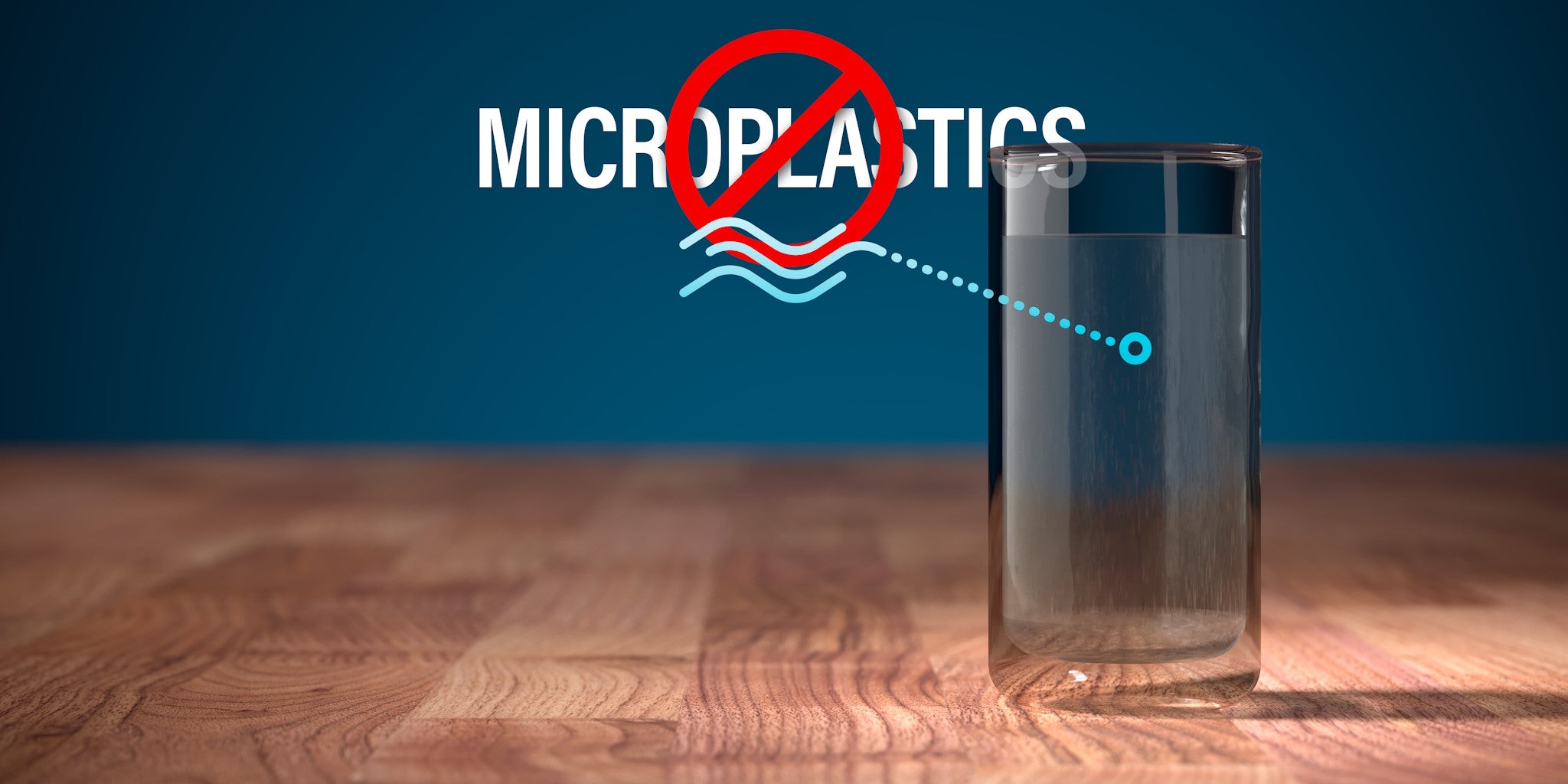Microplastics in water
In this blog, we aim to shed light on the detrimental effects of microplastics. Join us as we delve into the profound impact these tiny particles have on the environment and human well-being. By the end of this post, we will equip you with practical tips to eliminate microplastics from your water, ensuring a purer and healthier drinking experience. Discover the hidden dangers of microplastics and take steps towards a cleaner future!
Sadly, the escalating presence of plastic pollution within freshwater systems and terrestrial environments poses an imminent threat to both human well-being and ecological stability1. Given the ubiquity of plastics in virtually every facet of human existence, it is inevitable that individuals are consistently subjected to the presence of microplastics in their daily lives2.
What are microplastics in water?
Microplastics, which are artificial polymers that do not break down naturally and measure less than 5 mm in diameter, pose a significant concern3. Microbeads (<1 mm) are the primary source of particles found in cosmetics and cleaning agents, as well as fiber fragments released during the washing of clothes. Additionally, secondary sources include broken-down plastic litter and debris. The particles in question are predominantly composed of polyethylene, polypropylene, polystyrene, polyethylene terephthalate, and various polyesters4. As per Earth.org's findings, the annual influx of plastic waste into the oceans surpasses 8 million tonnes. Microplastics, like all other forms of plastic, endure a decomposition process spanning hundreds or even thousands of years. These minuscule particles pervade every nook and cranny of our surroundings, encompassing the air, soil, and water. Microplastics in drinking water, oceans, polar regions, and freshwater, have been found to harbour substantial quantities of hazardous substances. This pollution has led to the recognition that the ingestion of microplastics through food and water is a major pathway of exposure. These tiny particles have been detected in various samples of commonly consumed seafood, bottled water, tap water, honey, and even salt5.
The effect of microplastics in water and aquatic systems has far-reaching negative consequences. This is primarily because once plastics enter the marine environment, they can persist for hundreds and even thousands of years6. In the marine environment, plastic accounts for about 60–80% of marine garbage7.
Are there microplastics in tap water?
River water is a valuable resource to produce drinking water8. However, the escalating apprehension revolves around the presence of microplastics in drinking water, as their ingestion poses potential health risks to humans. It is crucial not to overlook the fact that microplastics can be found in drinking water. The extent of microplastics in drinking water primarily hinges upon the initial concentrations found in the raw water intake and the specific treatment methods employed in drinking water treatment facilities9. Drinking water treatment processes are essential to ensure adequate water quality, but they are not completely efficient in removing microplastics, as microplastic removal ranges between 70% and 82%10. Currently, there is neither any legislative limit for microplastic content in drinking water nor any treatment technology targeted directly at the removal of microplastics11.
Despite common assumptions about the purity of bottled water, you may be asking yourself is bottled water lower in microplastics? Recent research conducted by Cherniak et al. in 2022 reveals an unexpected finding: bottled water could potentially contain higher levels of microplastics12. World Health Organization (2019) has reported there is a growing interest to quantify microplastics occurrence in bottled water worldwide13.
Microplastic pollution has become such a global human health concern, since microplastics are emerging pollutants. To raise awareness of the issue, the revised European Drinking Water Directive has plans to include microplastics on “the watch list” of emerging compounds by 202414.
How to get rid of microplastics in water.
If you're keen to understand how to avoid microplastics in water, it’s time to start filtering your water with Doulton. Doulton Water Filters offer the convenience of drinking clean tap water that rivals the taste of bottled water. Extensive studies on microplastics in drinking water have primarily examined particles ranging from 6.5 to 100 microns in size. However, Doulton Water Filters goes a step further by providing an absolute filtration (defined as >99.99%) rating of 0.9 microns and a nominal filtration (defined as >99.9%) rating of 0.5 to 0.8 microns from your drinking water. This makes them an excellent choice for families seeking reassurance about the quality of their drinking water. While the research findings are undoubtedly concerning, individuals have the power to safeguard themselves and reduce their contribution to single-use plastic waste by opting not to purchase bottled water.
References
1. Sharma, V. K., Ma, X., Lichtfouse, E., & Robert, D. (2022). Nanoplastics are potentially more dangerous than microplastics. Environmental Chemistry Letters, 1-4.
2. Kirstein, I. V., Gomiero, A., & Vollertsen, J. (2021). Microplastic pollution in drinking water. Current Opinion in Toxicology, 28, 70-75.
3. Dronjak, L., Exposito, N., Rovira, J., Florencio, K., Emiliano, P., Corzo, B., ... & Sierra, J. (2022). Screening of microplastics in water and sludge lines of a drinking water treatment plant in Catalonia, Spain. Water Research, 225, 119185.
4. Wu, W. M., Yang, J., & Criddle, C. S. (2017). Microplastics pollution and reduction strategies. Frontiers of Environmental Science & Engineering, 11, 1-4.
5. Dronjak, L., Exposito, N., Rovira, J., Florencio, K., Emiliano, P., Corzo, B., ... & Sierra, J. (2022). Screening of microplastics in water and sludge lines of a drinking water treatment plant in Catalonia, Spain. Water Research, 225, 119185.
6. Issac, M. N., & Kandasubramanian, B. (2021). Effect of microplastics in water and aquatic systems. Environmental Science and Pollution Research, 28, 19544-19562.
7. Du, S., Zhu, R., Cai, Y., Xu, N., Yap, P. S., Zhang, Y., ... & Zhang, Y. (2021). Environmental fate and impacts of microplastics in aquatic ecosystems: a review. RSC advances, 11(26), 15762-15784.
8. Eerkes-Medrano, D., Leslie, H. A., & Quinn, B. (2019). Microplastics in drinking water: A review and assessment. Current Opinion in Environmental Science & Health, 7, 69-75.
9. Dalmau‐Soler, J., Ballesteros‐Cano, R., Ferrer, N., Boleda, M. R., & Lacorte, S. (2022). Microplastics throughout a tap water supply network. Water and Environment Journal, 36(2), 292-298.
10. Kirstein, I. V., Hensel, F., Gomiero, A., Iordachescu, L., Vianello, A., Wittgren, H. B., & Vollertsen, J. (2021). Drinking plastics?–Quantification and qualification of microplastics in drinking water distribution systems by µFTIR and Py-GCMS. Water Research, 188, 116519.
11. Novotna, K., Cermakova, L., Pivokonska, L., Cajthaml, T., & Pivokonsky, M. (2019). Microplastics in drinking water treatment–current knowledge and research needs. Science of the total environment, 667, 730-740.
12. Cherniak, S. L., Almuhtaram, H., McKie, M. J., Hermabessiere, L., Yuan, C., Rochman, C. M., & Andrews, R. C. (2022). Conventional and biological treatment for the removal of microplastics from drinking water. Chemosphere, 288, 132587.
13. World Health Organization. (2019). Microplastics in drinking water. Geneva: World Health Organization.
14. EU, 2020. Directive (EU) 2020/2184 of the European Parliament and of the Council of 16 December 2020 on the quality of water intended for human consumption (recast) (Text with EEA relevance). OJ L 435, 1–62 23.12.2020.
15. Eerkes-Medrano, D., Leslie, H. A., & Quinn, B. (2019). Microplastics in drinking water: A review and assessment. Current Opinion in Environmental Science & Health, 7, 69-75.






